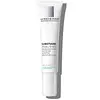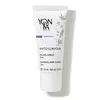What's inside
What's inside
 Key Ingredients
Key Ingredients

 Benefits
Benefits

 Concerns
Concerns

 Ingredients Side-by-side
Ingredients Side-by-side

Water
Skin ConditioningGlycerin
HumectantButyrospermum Parkii Butter
Skin ConditioningCyclohexasiloxane
EmollientPrunus Armeniaca Kernel Oil
MaskingPentaerythrityl Tetraethylhexanoate
EmollientIsohexadecane
EmollientZea Mays Starch
AbsorbentSilica
AbrasiveHydroxypropyl Tetrahydropyrantriol
Skin ConditioningCera Alba
EmollientStearic Acid
CleansingDimethicone
EmollientPalmitic Acid
EmollientPEG-100 Stearate
Glyceryl Stearate
EmollientPropylene Glycol
HumectantPEG-20 Stearate
EmulsifyingBis-PEG-18 Methyl Ether Dimethyl Silane
EmollientStearyl Alcohol
EmollientDimethiconol
EmollientArginine PCA
HumectantSerine
MaskingDisodium EDTA
Hydrolyzed Linseed Extract
Skin ConditioningAcetyl Dipeptide-1 Cetyl Ester
Skin ConditioningPolysorbate 80
EmulsifyingAcrylamide/Sodium Acryloyldimethyltaurate Copolymer
Emulsion StabilisingPentaerythrityl Tetra-Di-T-Butyl Hydroxyhydrocinnamate
AntioxidantSodium Benzoate
MaskingPhenoxyethanol
PreservativeBenzoic Acid
MaskingWater, Glycerin, Butyrospermum Parkii Butter, Cyclohexasiloxane, Prunus Armeniaca Kernel Oil, Pentaerythrityl Tetraethylhexanoate, Isohexadecane, Zea Mays Starch, Silica, Hydroxypropyl Tetrahydropyrantriol, Cera Alba, Stearic Acid, Dimethicone, Palmitic Acid, PEG-100 Stearate, Glyceryl Stearate, Propylene Glycol, PEG-20 Stearate, Bis-PEG-18 Methyl Ether Dimethyl Silane, Stearyl Alcohol, Dimethiconol, Arginine PCA, Serine, Disodium EDTA, Hydrolyzed Linseed Extract, Acetyl Dipeptide-1 Cetyl Ester, Polysorbate 80, Acrylamide/Sodium Acryloyldimethyltaurate Copolymer, Pentaerythrityl Tetra-Di-T-Butyl Hydroxyhydrocinnamate, Sodium Benzoate, Phenoxyethanol, Benzoic Acid
Rosmarinus Officinalis Water
MaskingLz1 Peptide
Aloe Barbadensis Leaf Juice
Skin ConditioningGlycerin
HumectantTocopherol
AntioxidantWater
Skin ConditioningRosmarinus Officinalis Leaf Oil
MaskingHydrogenated Palm Kernel Oil
EmollientPEG-35 Castor Oil
EmulsifyingGlyceryl Stearate
EmollientPEG-100 Stearate
Cera Alba
EmollientCetyl Alcohol
EmollientCorylus Avellana Seed Oil
EmollientCamphor
MaskingSclerotium Gum
Emulsion StabilisingCarbomer
Emulsion StabilisingFagus Sylvatica Bud Extract
TonicTocopheryl Acetate 0.2%
AntioxidantBorneol
MaskingSodium Hydroxide
BufferingLavandula Angustifolia Oil
MaskingPelargonium Graveolens Leaf Oil
Cupressus Sempervirens Oil
MaskingThymus Vulgaris Flower/Leaf Oil
MaskingPhenoxyethanol
PreservativeChlorphenesin
AntimicrobialBenzyl Alcohol
PerfumingBenzoic Acid
MaskingLimonene
PerfumingLinalool
PerfumingCitronellol
PerfumingGeraniol
PerfumingCoumarin
PerfumingRosmarinus Officinalis Water, Lz1 Peptide, Aloe Barbadensis Leaf Juice, Glycerin, Tocopherol, Water, Rosmarinus Officinalis Leaf Oil, Hydrogenated Palm Kernel Oil, PEG-35 Castor Oil, Glyceryl Stearate, PEG-100 Stearate, Cera Alba, Cetyl Alcohol, Corylus Avellana Seed Oil, Camphor, Sclerotium Gum, Carbomer, Fagus Sylvatica Bud Extract, Tocopheryl Acetate 0.2%, Borneol, Sodium Hydroxide, Lavandula Angustifolia Oil, Pelargonium Graveolens Leaf Oil, Cupressus Sempervirens Oil, Thymus Vulgaris Flower/Leaf Oil, Phenoxyethanol, Chlorphenesin, Benzyl Alcohol, Benzoic Acid, Limonene, Linalool, Citronellol, Geraniol, Coumarin
Ingredients Explained
These ingredients are found in both products.
Ingredients higher up in an ingredient list are typically present in a larger amount.
Benzoic Acid is used to preserve and adjust the pH of products.
The antimicrobial property of Benzoic Acid helps elongate a product's shelf life. Its main role is to reduce fungi growth and is not found to be effective at fighting bacteria. Therefore Benzoic Acid is always added along with other preservatives.
In its pure form, Benzoic Acid looks like a white crystalline solid. It has slight solubility in water.
The name of Benzoic Acid comes from gum benzoin, which used to be the sole source of deriving this ingredient. Benzoic Acid is the most simple aromatic carboxylic acid.
Benzoic Acid is naturally occuring in strawberries, mustard, cinnamon, and cloves. It has a slight scent but is not considered to be a fragrance.
Learn more about Benzoic AcidCera alba is beeswax, or the wax used by bees to make honeycombs. It is a texture-enhancer and emollient. A study from 2003 found beeswax to be a stronger emollient than ingredients such as petroleum jelly.
As an emollient, beeswax helps hydrate the skin by creating a barrier on top. This barrier traps moisture in.
Emulsifiers help prevent ingredients from separating. This helps create consistent texture.
The structure of beeswax is mainly long-chain alcohols and the esters of fatty acids.
There are three types of beeswax: yellow, white, and absolute. Yellow is pure beeswax taken from the honeycomb. White beeswax is created by filtering or bleaching yellow beeswax. Absolute beeswax is created by treating beeswax with alcohol. Beeswax used in cosmetics are purified.
Beeswax has been used throughout history and even in prehistoric times. Some common uses for beeswax still used today are making candles, as a waterproofing agent, and polish for leather.
Learn more about Cera AlbaGlycerin is already naturally found in your skin. It helps moisturize and protect your skin.
A study from 2016 found glycerin to be more effective as a humectant than AHAs and hyaluronic acid.
As a humectant, it helps the skin stay hydrated by pulling moisture to your skin. The low molecular weight of glycerin allows it to pull moisture into the deeper layers of your skin.
Hydrated skin improves your skin barrier; Your skin barrier helps protect against irritants and bacteria.
Glycerin has also been found to have antimicrobial and antiviral properties. Due to these properties, glycerin is often used in wound and burn treatments.
In cosmetics, glycerin is usually derived from plants such as soybean or palm. However, it can also be sourced from animals, such as tallow or animal fat.
This ingredient is organic, colorless, odorless, and non-toxic.
Glycerin is the name for this ingredient in American English. British English uses Glycerol/Glycerine.
Learn more about GlycerinGlyceryl Stearate is a mix of glycerin and stearic acid.
It is used to stabilize the mixing of water and oil ingredients. By preventing these ingredients from separating, it can help elongate shelf life. It can also help thicken the product's texture.
As an emollient, it helps soften skin and supports barrier-replenishing ingredients.
In cosmetics, Glyceryl Stearate is often made from vegetable oils or synthetically produced.
This ingredient may not be fungal-acne safe
Fun fact: The human body also creates Glyceryl Stearate naturally.
Learn more about Glyceryl StearatePeg-100 Stearate is an emollient and emulsifier. As an emollient, it helps keep skin soft by trapping moisture in. On the other hand, emulsifiers help prevent oil and water from separating in a product.
PEGS are a hydrophilic polyether compound . There are 100 ethylene oxide monomers in Peg-100 Stearate. Peg-100 Stearate is polyethylene glycol ester of stearic acid.
Phenoxyethanol is a preservative that has germicide, antimicrobial, and aromatic properties. Studies show that phenoxyethanol can prevent microbial growth. By itself, it has a scent that is similar to that of a rose.
It's often used in formulations along with Caprylyl Glycol to preserve the shelf life of products.
Water. It's the most common cosmetic ingredient of all. You'll usually see it at the top of ingredient lists, meaning that it makes up the largest part of the product.
So why is it so popular? Water most often acts as a solvent - this means that it helps dissolve other ingredients into the formulation.
You'll also recognize water as that liquid we all need to stay alive. If you see this, drink a glass of water. Stay hydrated!
Learn more about Water